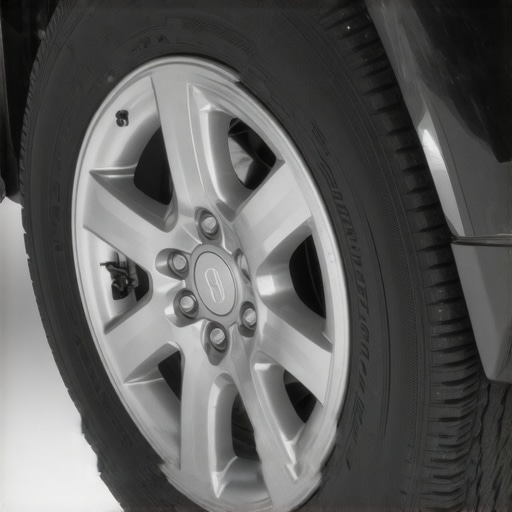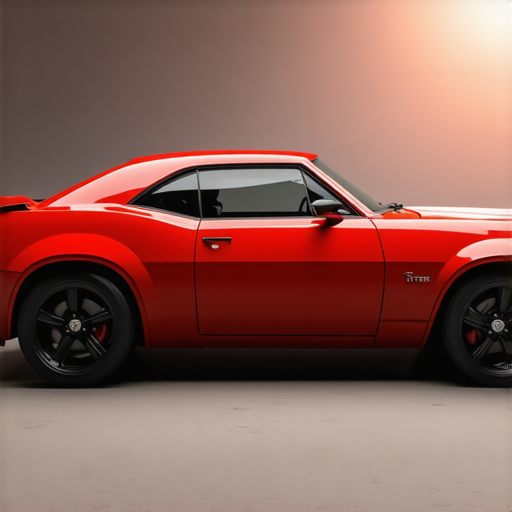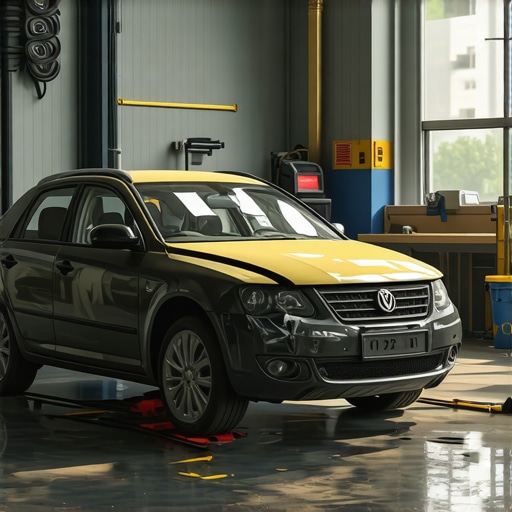My Unexpected Encounter with a Car Collision: A Wake-Up Call for Better Repairs
It all started one rainy evening when I barely avoided a fender bender that left my car with more than just a few scratches. As I stared at the dented side panel, I realized how crucial it was to find a trusted collision repair shop that could restore my vehicle to its former glory. That experience sparked my journey into understanding the nuances of car body repair and collision restoration.
What Makes a Top Car Body Repair Shop Stand Out?
Over the years, I’ve learned that the best collision repair centers, like CollisionRenew, focus on quality, transparency, and customer satisfaction. Their technicians aren’t just fixing dents—they’re restoring safety and aesthetics. When I first visited CollisionRenew, their team explained the repair process in detail, which built my confidence in their expertise. I appreciated their use of advanced tools and adherence to manufacturer standards, ensuring my vehicle’s integrity was maintained.
My Secret to Choosing the Right Collision Restoration Service
Choosing the right collision restoration service can be overwhelming. I look for certifications, positive reviews, and a portfolio of successful repairs. A noteworthy aspect I discovered is their use of OEM (Original Equipment Manufacturer) parts, which I found out from an article on Auto Service Professional, helps maintain the vehicle’s value and safety. My experience with CollisionRenew confirmed that a reputable shop understands the importance of detailed craftsmanship and genuine parts.
Why Is Proper Collision Repair Essential for Your Vehicle’s Safety?
Proper collision repair isn’t just about aesthetics; it’s about ensuring your car’s safety features work correctly. For example, frame alignment and airbag system recalibration are critical post-collision steps. After my own repair, I realized how much attention to detail impacts overall safety, and I now prioritize using certified repair shops that follow strict standards.
If you’ve ever been in a minor or major accident, I’d love to hear your experiences. Sharing stories can help others make informed decisions about collision repair services.
My Final Thoughts on Restoring Your Vehicle with Confidence
From my personal experience, trusting a top-tier collision restoration shop like CollisionRenew makes all the difference. Their commitment to quality and customer care reassured me throughout the repair process. Remember, investing in proper collision repair not only preserves your car’s appearance but also ensures your safety on the road.
How Do OEM Parts Elevate Your Vehicle’s Safety and Longevity?
When considering collision repair, one of the most important decisions is whether to opt for OEM (Original Equipment Manufacturer) parts or aftermarket alternatives. As I delved deeper into the repair industry, I discovered that OEM parts are engineered specifically for your vehicle, ensuring perfect fit, function, and safety. This precision not only preserves the vehicle’s original integrity but also reinforces safety features such as crashworthiness and airbag deployment mechanisms.
For example, a study by the National Highway Traffic Safety Administration (NHTSA) highlights that vehicles repaired with OEM parts tend to maintain their crash safety ratings more reliably over time, which is crucial in safeguarding occupants during a collision. Using genuine parts also guarantees that your car remains in compliance with manufacturer standards, helping retain resale value and warranty coverage.
What Are the Practical Implications of Using Genuine Parts in Your Repairs?
Beyond safety, OEM parts contribute significantly to the vehicle’s overall performance and durability. They undergo rigorous testing and quality control, making them more reliable than many aftermarket options. During my visits to reputable repair shops, I observed that technicians often prefer OEM parts because they fit seamlessly without the need for modifications, reducing the risk of future issues.
This seamless fit also plays a role in maintaining your vehicle’s appearance. Misaligned or poorly fitted aftermarket parts can cause uneven gaps, paint mismatches, and compromised aerodynamics—factors that diminish the aesthetic appeal and potentially affect fuel efficiency.
Is there a cost trade-off when choosing OEM parts over aftermarket alternatives?
While OEM parts can be more expensive upfront, their benefits often justify the initial investment. They tend to last longer and perform better, reducing the likelihood of future repairs—saving you money and hassle in the long run. Moreover, many insurance policies favor OEM parts, which can streamline your claims process and prevent disputes over repair quality.

To help visualize the difference, here’s an image illustrating OEM versus aftermarket parts, highlighting fit and finish quality. Properly fitted parts are critical to restoring your vehicle’s safety and value.
If you’re interested in learning more about the technical standards and quality assurance processes behind OEM parts, I recommend exploring resources provided by Auto Industry.org. Their comprehensive guides shed light on how genuine parts contribute to a safer, more reliable vehicle.
Engage and Share Your Experiences
Have you had a collision repair experience where choosing OEM parts made a noticeable difference? Or perhaps you have questions about the repair process? Share your stories or ask for advice in the comments below. For those looking to deepen their understanding, I suggest exploring our detailed guides on collision repair best practices and maintenance tips to keep your vehicle in optimal condition.
What Are the Hidden Nuances in OEM Parts That Impact Your Vehicle’s Performance?
As I immersed myself further into the world of collision repairs, I realized that OEM parts are not just about brand and fit—they embody a complex synergy of engineering precision, material science, and safety standards. Each OEM component undergoes rigorous testing, often exceeding industry benchmarks, to ensure that it not only matches the original specifications but also enhances the vehicle’s overall integrity over time.
For instance, OEM bumpers are designed with energy absorption in mind, which can drastically influence crash safety outcomes. When I had my own vehicle repaired, I learned from technicians that OEM parts often include proprietary features—like specific crumple zones or reinforcement bars—that aftermarket parts might lack or inadequately replicate. This realization deepened my appreciation for how OEM parts contribute to the nuanced safety architecture of modern vehicles.
How Do OEM Parts Influence Long-Term Vehicle Resilience?
Research from the National Highway Traffic Safety Administration indicates that vehicles repaired with genuine OEM parts tend to preserve their original crashworthiness ratings much longer than those with aftermarket parts. This means that your car’s safety performance in the event of future collisions is likely to be more reliable and predictable, reinforcing the importance of choosing OEM components during repair.
From my perspective, this long-term resilience is invaluable. It’s like investing in a quality foundation—initially more costly, but ultimately saving you money and worry by reducing the need for future repairs or safety concerns. I found that insurance companies often recognize this value, sometimes even offering incentives for OEM parts, which can offset the initial expense.
Beyond Safety: How OEM Parts Preserve Your Vehicle’s Authenticity and Value
Another aspect I’ve come to appreciate is how OEM parts maintain the vehicle’s original aesthetic and resale value. When aftermarket parts don’t precisely match the factory specifications, they can cause visual discrepancies—think misaligned panels or mismatched paint—that diminish the vehicle’s appeal and value. During my own repair experience, I watched technicians meticulously fit OEM panels, ensuring seamless integration that preserved my car’s original look and feel.
This attention to detail, rooted in OEM manufacturing standards, is especially critical for vintage or luxury vehicles where authenticity significantly impacts worth. It’s a reminder that investing in OEM parts isn’t just about safety; it’s about honoring the vehicle’s legacy and ensuring it remains attractive and valuable in the long run.
What Are the Practical Considerations When Opting for OEM Parts?
While the benefits are clear, I recognize that cost remains a concern for many. However, the slight premium paid upfront often translates into substantial savings down the line—fewer repairs, better safety, and higher resale value. Moreover, many reputable repair shops and insurance policies now recognize the importance of OEM parts, streamlining the claims process and reducing disputes over repair quality.
If you’re considering your options, I recommend consulting with your repair technician about the specific parts needed for your vehicle and weighing the safety and longevity benefits of OEM components. Sometimes, a detailed discussion can reveal nuances that align better with your driving needs and budget.
For those eager to explore further, I suggest visiting CollisionRenew and Auto Industry.org for comprehensive guides and industry standards that underscore the critical role OEM parts play in vehicle safety and performance.
Share Your Experience and Join the Conversation
If you’ve had a collision repair where opting for OEM parts made a noticeable difference, I’d love to hear your story. Or perhaps you’re still weighing the costs and benefits—whatever your experience, sharing can help others make informed decisions. Feel free to comment below or explore our related content on collision repair best practices and maintenance tips to keep your vehicle in optimal condition.
Unveiling the Hidden Engineering Marvels of OEM Parts
As I delved further into the intricacies of collision repair, I was struck by how OEM (Original Equipment Manufacturer) parts embody a symphony of engineering precision, material science, and safety standards. Each component, meticulously designed and rigorously tested, plays a pivotal role in preserving the structural integrity and safety features of your vehicle. Unlike aftermarket alternatives, OEM parts are crafted to meet or exceed the original specifications, ensuring seamless integration and optimal performance.
How Do OEM Components Fortify Your Vehicle’s Long-Term Resilience?
Research from the National Highway Traffic Safety Administration underscores that vehicles restored with genuine OEM parts maintain their crashworthiness ratings significantly longer than those with aftermarket parts. This enduring resilience means that in the unfortunate event of a future collision, your vehicle’s safety systems—such as crumple zones, reinforcement bars, and energy absorption features—will perform as originally intended, offering peace of mind and reliable protection.
The Impact of OEM Parts on Vehicle Authenticity and Resale Value
Beyond safety, OEM parts are instrumental in maintaining your vehicle’s authentic aesthetic and market value. Misaligned or poorly fitted aftermarket parts can create visual discrepancies, diminishing appeal and resale potential. During my own repair journey, I observed technicians precisely fitting OEM panels, ensuring that my car retained its factory finish and structural harmony. This meticulous attention to detail is essential, especially for vintage or luxury models where authenticity directly influences worth.
What Are the Nuanced Advantages of Choosing OEM Over Aftermarket Parts?
While OEM parts often come with a higher price tag, their benefits extend beyond immediate repairs. They offer superior durability, better fitment, and compatibility with advanced safety systems, reducing the likelihood of future issues. According to industry standards, OEM components undergo rigorous testing, often surpassing industry benchmarks, to ensure longevity and performance. This investment enhances your car’s overall resilience and can even streamline insurance claims, as many insurers recognize the value of OEM parts in maintaining vehicle integrity.

Here’s an illustrative image showcasing OEM versus aftermarket parts, emphasizing fit and finish quality—crucial for safety and aesthetic harmony. Properly fitted OEM components ensure your vehicle remains a reliable and authentic extension of your driving identity.
If you’re eager to explore the technical nuances and standards that make OEM parts superior, I recommend visiting Auto Industry.org. Their comprehensive guides provide an in-depth understanding of how genuine parts uphold safety, performance, and long-term value.
Engage and Share Your OEM Parts Experiences
If you’ve experienced the difference OEM parts make during collision repair, I invite you to share your story. Whether it’s about safety, durability, or resale value, your insights can help others navigate their choices. Feel free to comment below or delve into related content on collision repair best practices and maintenance strategies to keep your vehicle in top condition.
Things I Wish I Knew Earlier (or You Might Find Surprising)
The Real Difference Is in the Details
When I first started exploring collision repair options, I underestimated how much the quality of parts impacts safety and longevity. Discovering that OEM parts are meticulously designed to match your vehicle’s original specifications was a game-changer for me, emphasizing that not all parts are created equal.
Beyond the Surface: Safety Features Are Complex
It’s easy to focus on looks, but I learned that OEM parts play a crucial role in maintaining safety features like crumple zones and airbag deployment. A minor misfit can compromise these systems, which was eye-opening for me and made me appreciate choosing certified repair shops even more.
The Cost Trade-Off Is Worth It
I used to think aftermarket parts were a budget-friendly solution, but I realized that OEM parts, despite a higher upfront cost, often save money long-term by reducing future repairs and maintaining resale value. It’s like investing in quality for peace of mind.
The Resale Value Matters More Than You Think
When I kept my vehicle with OEM parts, I noticed how much better it looked and felt, which helped preserve its value. A seamless, factory-finish repair made all the difference in keeping my car attractive for future buyers.
Industry Standards Are Not Created Equal
Learning about industry standards and how OEM parts surpass many aftermarket options, I realized that trusting reputable sources like Auto Industry.org can help you make informed decisions about your vehicle’s repairs and parts choices.
Resources I’ve Come to Trust Over Time
- CollisionRenew: Their commitment to quality and transparency has made me confident in my repairs. I recommend checking them out for reliable collision restoration services.
- Auto Industry.org: This site provides comprehensive guides and standards about OEM parts and safety features, which deepened my understanding and trust.
- NHTSA (National Highway Traffic Safety Administration): Their research and crash safety data helped me see the long-term benefits of OEM parts in maintaining vehicle integrity.
Parting Thoughts from My Perspective
Reflecting on my journey, I realize that choosing OEM parts and reputable collision repair shops is an investment in my safety, vehicle longevity, and peace of mind. It’s tempting to cut costs initially, but the true value lies in the durability, safety, and resale potential that genuine, OEM components provide. If you’ve experienced the difference OEM parts make, I’d love to hear your story. Feel free to share your thoughts or ask questions below—your insights might help someone else make a smarter choice on their vehicle repairs.

